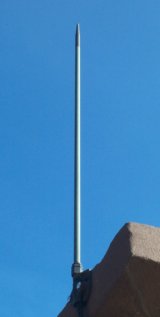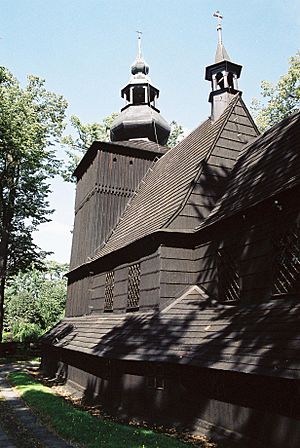Lightning rod facts for kids
A lightning rod is a special metal rod used to protect buildings from lightning strikes. It's also called a lightning conductor. This rod is part of a bigger system designed to keep structures safe. Lightning rods are usually placed on the highest parts of buildings. They help guide the powerful electricity of a lightning bolt safely into the ground. This invention was first thought of around 1749 and improved in 1752.
Contents
The Story of Lightning Rods
Lightning can cause a lot of damage to buildings made of wood, concrete, or even steel. The huge electrical currents from lightning can heat materials very quickly. This can lead to fires, weakened structures, and even explosions from super-heated steam.
Early Ideas in Europe
In old European towns, church towers were often the tallest buildings. This meant they were hit by lightning very often. People used to pray to protect themselves from lightning. Some even thought it was safer to be anywhere but near a church during a storm.
The idea of a lightning rod in Europe came from a scientist and religious scholar named Václav Prokop Diviš. Between 1750 and 1754, he invented the first grounded lightning rod. He put it up on July 15, 1754, in his garden. His invention had many sharp metal spikes on top of a tall pole. Metal chains connected the pole to iron cones buried in the ground.
Diviš called his invention a 'weather machine'. He hoped it would slowly pull electricity from clouds to stop lightning and storms. If that didn't work, it was also designed to attract lightning and send it safely to the ground. He suggested his machine could protect church towers and ships. Other scientists, like Leonhard Euler, even wrote about his machine.
In 1755, Diviš asked the Emperor of Austria if he could build more of these machines. But the mathematicians in Vienna said no. Later, in 1760, some angry villagers tore down his machine. They blamed him for a drought that year. However, after summer storms caused a lot of damage, the villagers asked him to rebuild it. He did, and he also built another one on a church tower.
Benjamin Franklin and the United States
In the United States, the pointed lightning rod was invented by Benjamin Franklin. He was famous for his work with electricity. Franklin believed that a sharp iron rod could gently pull electrical energy from a cloud. This would happen before the cloud got close enough to strike.
Franklin thought about lightning rods for several years. He even did his famous kite experiment because he was waiting for a church in Philadelphia to be finished. He wanted to put a lightning rod on top of it. Some churches at the time didn't like the idea. They felt it was going against God's will. Franklin argued that putting a roof on a building to stop rain was similar. Since he proved lightning was just a giant electrical spark, protecting buildings from it was no different. Franklin was a kind person and decided not to get a patent for his invention. He wanted everyone to be able to use it.
In the 1800s, the lightning rod became a symbol of American cleverness. They were often decorated with fancy glass balls. These glass balls are now collected by people who enjoy old items.
Sometimes, solid glass balls were used on ships. People thought they would stop lightning strikes. This idea didn't work, but it shows how people thought about science back then. Glass doesn't conduct electricity well, so it's rarely hit by lightning. People thought this meant glass somehow pushed lightning away. So, they would bury a small glass ball in the tallest mast of a wooden ship. Because lightning strikes are random, this method sometimes seemed to work, even though it didn't really help.
Later, Nikola Tesla improved lightning protectors. His design fixed a problem with Franklin's original idea. Franklin's pointed rod actually makes the air around it more conductive. This can sometimes make a strike more likely. Tesla's improved method was designed to avoid this.
Images for kids
-
Nevyansk Tower in Russia crowned with a metallic rod grounded through a complex system of rebars (some are seen at the basement)
-
Drawing of a general store by Marguerite Martyn in the St. Louis Post-Dispatch of October 21, 1906, with a traveling salesman selling lightning rods
-
Lightning protection system at a launch pad at Cape Canaveral Space Force Station.
-
Landscape suited for purpose of explanation: (1) Represents Lord Kelvin's "reduced" area of the region; (2) Surface concentric with the Earth such that the quantities stored over it and under it are equal; (3) Building on a site of excessive electrostatic charge density; (4) Building on a site of low electrostatic charge density. (Image via U.S. Patent 1,266,175.)
See also
 In Spanish: Pararrayos para niños
In Spanish: Pararrayos para niños












